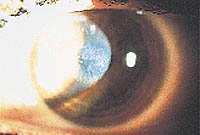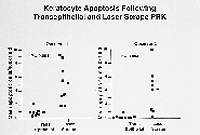Researchers consider current and future ways to cure haze
Now, surgical techniques can inhibit keratocyte apoptosis, which causes haze.
Click Here to Manage Email Alerts
VIENNA, Austria — Researchers want to control apoptosis after refractive laser procedures as a way of controlling postoperative haze.
Steven E. Wilson, MD, is professor and chair of the Department of Ophthalmology at the University of Washington in Seattle. He spoke at the European Society of Cataract and Refractive Surgeons meeting.
Any source of epithelial injury can trigger keratocyte apoptosis, Dr. Wilson said. Apoptosis is an involuntary cell death with minimal inflammation, minimal release of degradative enzymes and minimal collateral damage to surrounding cells and tissues.
“Scarring following corneal procedures is common after photorefractive keratectomy [PRK], but almost all of these are clinically insignificant,” Dr. Wilson said. “Late haze, which occurs in 0.1% to 0.5% of patients, is the one that we really worry about.”
How haze happens
 ---Late haze occurs in between 0.1% and 0.5% of patients.
---Late haze occurs in between 0.1% and 0.5% of patients.
Keratocyte apoptosis is triggered by cytokines released from injured epithelial cells. These cytokines include IL-1, Fas ligand and BMP2/4. These cytokines act as initiators of the complex wound healing cascade. There are nine major steps in the cascade of corneal wound healing: epithelial injury; keratocyte apoptosis; proliferation of remaining keratocytes; repopulation of stroma with myofibroblasts; inflammatory cell infiltration; increased disorganized collagen; increased production of growth factors controlling stromal wound healing (TGF-b) and epithelial hyperplasia (HGF); epithelial hyperplasia, stromal remodeling; and slow return to a more normal epithelial and stromal morphology.
Each of these events is mediated by cytokine cascades. The working hypo-thesis is that keratocyte apoptosis is the initiator of the wound healing response. Anything that promotes keratocyte apoptosis will have the effect of promoting wound healing.
“Many of the studies over the past years have shown that keratocyte apoptosis or programmed cell death is triggered by cytokines released from epithelial cells,” Dr. Wilson said. “We hypothesize that keratocyte apoptosis is the initiator of the complex wound healing cascade.”
Complex cascade
 ---Two observers compared rabbit corneas after two surgical PRK methods. Transepithelial PRK might be one way to eliminate haze and reduce wound healing.
---Two observers compared rabbit corneas after two surgical PRK methods. Transepithelial PRK might be one way to eliminate haze and reduce wound healing.
Most of the repopulating fibroblasts are myofibroblasts and they produce disorganized collagen and growth factors such as HGF. This results in epithelial hyperplasia or thickening associated with regression of PRK and to a lesser extent in laser in situ keratomileusis (LASIK).
Haze or scarring is common after PRK. Almost all cases are clinically insignificant. Late haze occurs in between 0.1% to 0.5% of patients. It does not occur in patients with less than 5 D of attempted correction.
Methods for limiting keratocyte apoptosis may have the effect of promoting a more controlled healing of LASIK or PRK. These methods are primarily confined to surgical techniques such as transepithelial PRK in which the laser is used to ablate completely through the epithelium, which is associated with diminished keratocyte apoptosis compared with laser scrape PRK. Laser scrape PRK is not transepithelial PRK. Laser scrape has a keratocyte apoptosis response just like fully scraping the epithelium.
There is a wound healing response after LASIK, as well, Dr. Wilson said.
Haze may occur after LASIK in sands of the Sahara syndrome, or in unusual cases with idiopathic lamellar haze. Regression is common after LASIK. About 10% of patients experience regression that requires enhancement. Among this group, a 5% to 10% mean regression occurs at 1 year.
The response of keratocyte apoptosis in LASIK occurs along the lamellar interface from epithelial debris tracked in by the microkeratome blade. This keratocyte apoptosis and the subsequent wound healing events are farther away from the overlying epithelium than in PRK, and have less effect on epithelial hyperplasia. Therefore, Dr. Wilson said, LASIK is better than PRK for higher corrections.
“There are steps that you can do to limit the keratocyte apoptosis response,” he said. “The LASIK interface is not pristine, the microkeratome breaks open epithelial cells in the periphery and carries in these cytokines and cellular epithelial debris into the interface. Therefore, the interface should be cleaned by irrigation with balanced salt solution.”
Novel methods
In addition to the known surgical techniques, researchers are looking at pharmacological ways to block apoptosis. One potential candidate is cyclosporine A, but researchers need to figure out a way to block both major apoptosis pathways. Toward this end, they are trying combination drugs of cyclosporine and other pharmacological agents. Caspase inhibitors (CASP-8 and CASP-9) are being examined, as well as other agents.
Finally, Dr. Wilson and Gregory Schultz, PhD, at the University of Florida, Gainesville, are studying delivery of anti-apoptotic genes such as P-35, either to the anterior stroma at the time of epithelial removal before PRK, or in the interface at the time of LASIK, to block transiently the apoptotic response.
“We hope that these studies will allow us to answer the question whether blocking apoptosis will, in fact, control wound healing in LASIK and whether this is a viable technique to apply,” he said.
For Your Information:
- Steven E. Wilson, MD, is professor and chair of the Department of Ophthalmology at the University of Washington in Seattle. He can be reached at Department of Ophthalmology, Box 356485, University of Washington, Seattle, WA 98195; (206) 543-7250; fax: (206) 543-4414. Dr. Wilson has no direct financial interest in any of the products mentioned in this article. He is a paid consultant for Allergan.
